Science & Environment
What life is like for Nasa astronauts Suni Williams and Butch Wilmore
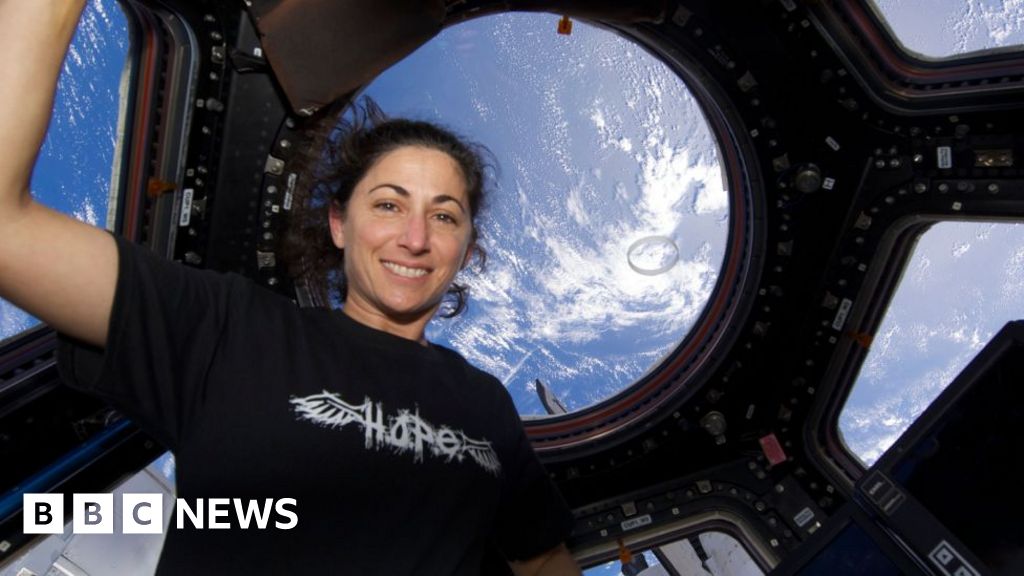
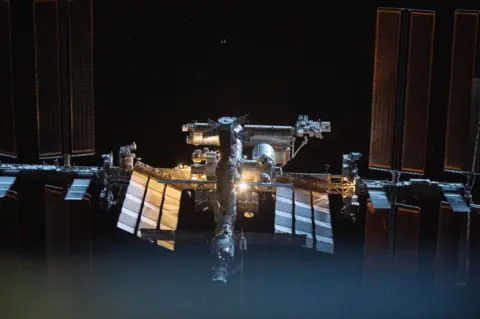 NASA
NASAIn June two American astronauts left Earth expecting to spend eight days on the International Space Station (ISS).
But after fears that their Boeing Starliner spacecraft was unsafe to fly back on, Nasa delayed Suni Williams and Butch Wilmore’s return until 2025.
They are now sharing a space about the size of a six-bedroom house with nine other people.
Ms Williams calls it her “happy place” and Mr Wilmore says he is “grateful” to be there.
But how does it really feel to be 400km above Earth? How do you deal with tricky crewmates? How do you exercise and wash your clothes? What do you eat – and, importantly, what is the “space smell”?
Talking to BBC News, three former astronauts divulge the secrets to surviving in orbit.

Every five minutes of the astronauts’ day is divided up by mission control on Earth.
They wake early. At around 06:30 GMT, astronauts emerge from the phone-booth size sleeping quarter in the ISS module called Harmony.
“It has the best sleeping bag in the world,” says Nicole Stott, an American astronaut with Nasa who spent 104 days in space on two missions in 2009 and 2011.
The compartments have laptops so crew can stay in contact with family and a nook for personal belongings like photographs or books.

The astronauts might then use the bathroom, a small compartment with a suction system. Normally sweat and urine is recycled into drinking water but a fault on the ISS means the crew must currently store urine instead.
Then the astronauts get to work. Maintenance or scientific experiments take up most time on the ISS, which is about the size of Buckingham Palace – or an American football field.
“Inside it’s like many buses all bolted together. In half a day you might never see another person,” explains Canadian astronaut Chris Hadfield, commander on the Expedition 35 mission in 2012-13.
“People just don’t go zipping through the station. It’s big and it’s peaceful,” he says.

The ISS has six dedicated labs for experiments, and astronauts wear heart, brain or blood monitors to measure their responses to the challenging physical environment.
“We’re guinea pigs,” says Ms Stott, adding that “space puts your bones and muscles into an accelerated ageing process, and scientists can learn from that”.
If the astronauts can, they work faster than mission control predicts.
Mr Hadfield explains: “Your game is to find five free minutes. I would float to the window to watch something go by. Or write music, take photographs or write something for my children.”
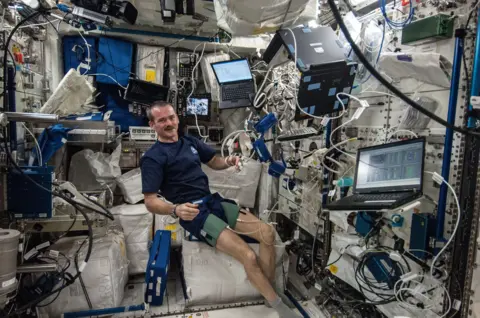 Nasa
NasaA lucky few are asked to do a spacewalk, leaving the ISS for the space vacuum outside. Mr Hadfield has done two. “Those 15 hours outside, with nothing between me and the universe but my plastic visor, was as stimulating and otherworldly as any other 15 hours of my life.”
But that spacewalk can introduce something novel to the space station – the metallic “space smell”.
“On Earth we have lots of different smells, like washing machine laundry or fresh air. But in space there’s just one smell, and we get used to it quickly,” explains Helen Sharman, the first British astronaut, who spent eight days on the Soviet space station Mir in 1991.
Objects that go outside, like a suit or scientific kit, are affected by the strong radiation of space. “Radiation forms free radicals on the surface, and they react with oxygen inside the space station, creating a metallic smell,” she says.
When she returned to Earth, she valued sensory experiences much more. “There’s no weather in space – no rain on your face and or wind in your hair. I appreciate those so much more to this day now,” she says, 33 years later.
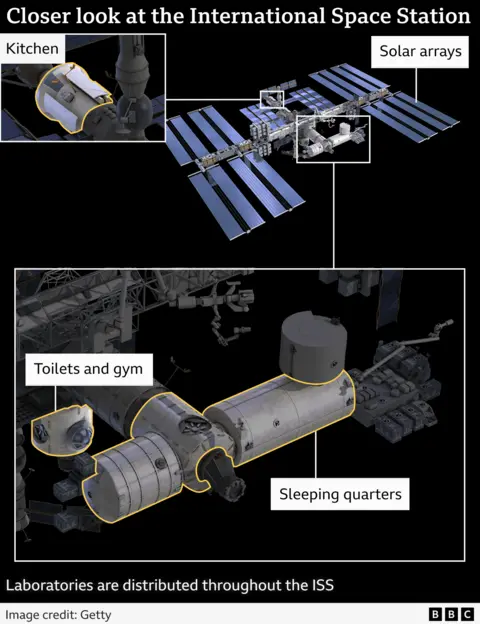
In between working, astronauts on long stays must do two hours of exercise daily. Three different machines help to counter the effect of living in zero gravity, which reduces bone density.
The Advanced Resistive Exercise Device (ARED) is good for squats, deadlifts, and rows that work all the muscle groups, says Ms Stott.
Crew use two treadmills that they must strap into to stop themselves floating away, and a cycle ergometer for endurance training.

‘One pair of trousers for three months’
All that work creates a lot of sweat, Ms Stott says, leading to a very important issue – washing.
“We don’t have laundry – just water that forms into blobs and some soapy stuff,” she explains.
Without gravity pulling sweat off the body, the astronauts get covered in a coating of sweat – “way more than on Earth”, she says.
“I would feel the sweat growing on my scalp – I had to swab down my head. You wouldn’t want to shake it because it just would fly everywhere.”
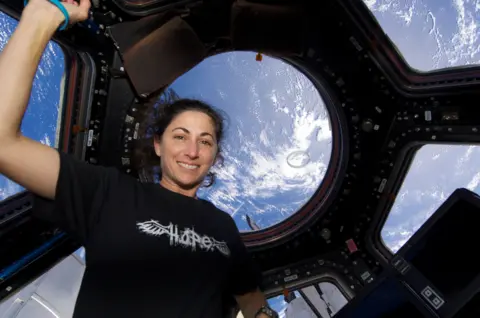 Nasa
NasaThose clothes become so dirty that they are thrown out in a cargo vehicle that burns up in the atmosphere.
But their daily clothes stay clean, she says.
“In zero-gravity, clothes float on the body so oils and everything else don’t affect them. I had one pair of trousers for three months,” she explains.
Instead food was the biggest hazard. “Somebody would open up a can, for example, meats and gravy,” she says.
“Everybody was on alert because little balls of grease drifted out. People floated backwards, like in the Matrix film, to dodge the balls of meat juice.”

At some point another craft might arrive, bringing a new crew or supplies of food, clothes, and equipment. Nasa sends a few supply vehicles a year. Arriving at the space station from Earth is “amazing”, says Mr Hadfield.
“It’s a life-changing moment when you catch sight of the ISS there in the eternity of the universe – seeing this little bubble of life, a microcosm of human creativity in the blackness,” he says.
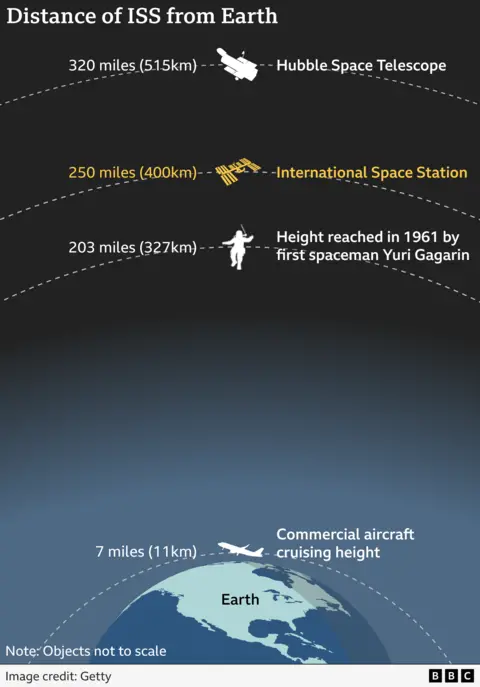
After a hard day’s work, it is time for dinner. Food is mostly reconstituted in packets, separated into different compartments by nation.
“It was like camping food or military rations. Good but it could be healthier,” Ms Stott says.
“My favourite was Japanese curries, or Russian cereal and soups,” she says.
Families send their loved ones bonus food packs. “My husband and son picked little treats, like chocolate-covered ginger,” she says.
The crew share their food most of the time.
Astronauts are pre-selected for personal attributes – tolerant, laid-back, calm – and trained to work as a team. That reduces the likelihood of conflict, explains Ms Sharman.
“It’s not just about putting up with somebody’s bad behaviour, but calling it out. And we always give each other metaphorical pats-on-the back to support each other,” she says.
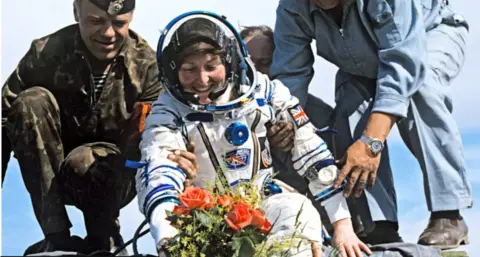 Ria Novosti/Science Photo Library
Ria Novosti/Science Photo LibraryLocation, location, location
And finally, bed again, and time to rest after a day in a noisy environment (fans run constantly to disperse pockets of carbon dioxide so the astronauts can breathe, making it about as loud as a very noisy office).
“We can have eight hours of sleep – but most people get stuck in the window looking at Earth,” Ms Stott says.
All three astronauts talked about the psychological impact of seeing their home planet from 400km in orbit.
“I felt very insignificant in that vastness of space,” Ms Sharman says. “Seeing Earth so clearly, the swirls of clouds and the oceans, made me think about the geopolitical boundaries that we construct and how actually we are completely interconnected.”
Ms Stott says she loved living with six people from different countries “doing this work on behalf of all life on Earth, working together, figuring out how to deal with problems”.
“Why can’t that be happening down on our planetary spaceship?” she asks.
Eventually all astronauts must leave the ISS – but these three say they would return in a heartbeat.
They don’t understand why people think the Nasa astronauts Suni Williams and Butch Wilmore are “stranded”.
“We dreamed, worked and trained our entire lives hoping for an extended stay in space,” says Mr Hadfield. “The greatest gift you can give a professional astronaut is to let them stay longer.”
And Ms Stott says that as she left the ISS she thought: “You’re gonna have to pull my clawing hands off the hatch. I don’t know if I’m going to get to come back.”
Graphics by Katherine Gaynor and Camilla Costa
Science & Environment
Drones setting a new standard in ocean rescue technology
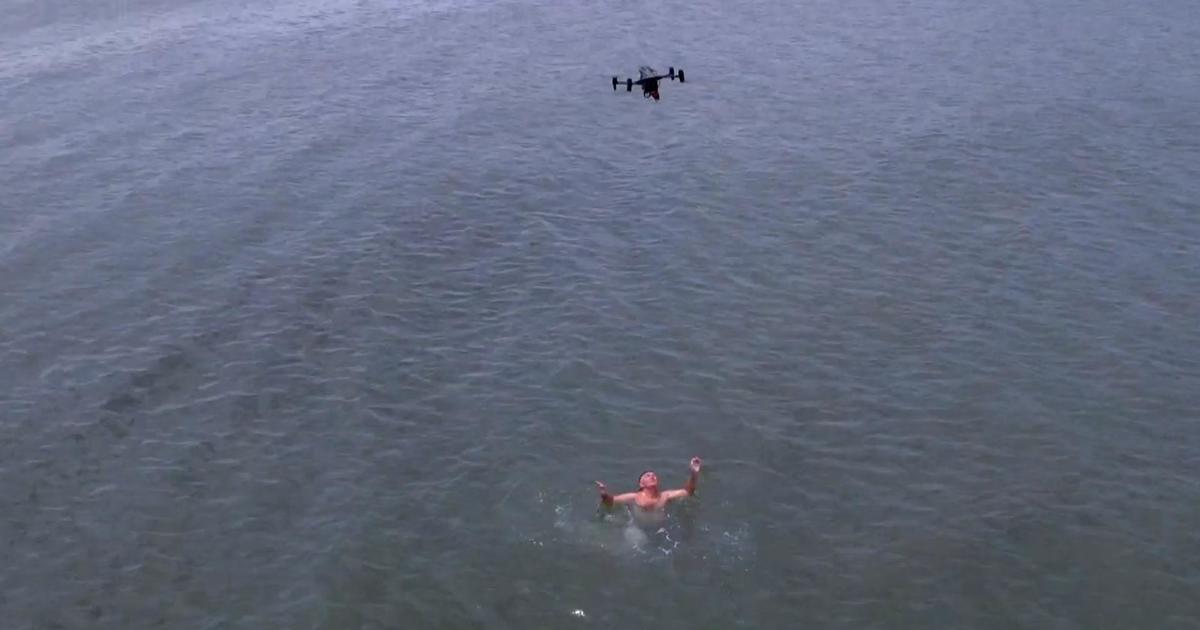
Last month, two young paddleboarders found themselves stranded in the ocean, pushed 2,000 feet from the shore by strong winds and currents. Thanks to the deployment of a drone, rescuers kept an eye on them the whole time and safely brought them aboard a rescue boat within minutes.
In North Carolina, the Oak Island Fire Department is one of a few in the country using drone technology for ocean rescues. Firefighter-turned-drone pilot Sean Barry explained the drone’s capabilities as it was demonstrated on a windy day.
“This drone is capable of flying in all types of weather and environments,” Barry said.
Equipped with a camera that can switch between modes — including infrared to spot people in distress — responders can communicate instructions through a speaker. It also can carry life-preserving equipment.
The device is activated by a CO2 cartridge when it comes in contact with water. Once triggered, it inflates into a long tube, approximately 26 inches long, providing distressed swimmers something to hold on to.
In a real-life rescue, after a 911 call from shore, the drone spotted a swimmer in distress. It released two floating tubes, providing the swimmer with buoyancy until help arrived.
Like many coastal communities, Oak Island’s population can swell from about 10,000 to 50,000 during the summer tourist season. Riptides, which are hard to detect on the surface, can happen at any time.
Every year, about 100 people die due to rip currents on U.S. beaches. More than 80% of beach rescues involve rip currents, if you’re caught in one, rescuers advise to not panic or try to fight it, but try to float or swim parallel to the coastline to get out of the current.
Oak Island Fire Chief Lee Price noted that many people underestimate the force of rip currents.
“People are, ‘Oh, I’m a good swimmer. I’m gonna go out there,’ and then they get in trouble,” Price said.
For Price, the benefit of drones isn’t just faster response times but also keeping rescuers safe. Through the camera and speaker, they can determine if someone isn’t in distress.
Price said many people might not be aware of it.
“It’s like anything as technology advances, it takes a little bit for everybody to catch up and get used to it,” said Price.
In a demonstration, Barry showed how the drone can bring a safety rope to a swimmer while rescuers prepare to pull the swimmer to shore.
“The speed and accuracy that this gives you … rapid deployment, speed, accuracy, and safety overall,” Price said. “Not just safety for the victim, but safety for our responders.”
Science & Environment
Horseshoe crabs: Ancient creatures who are a medical marvel
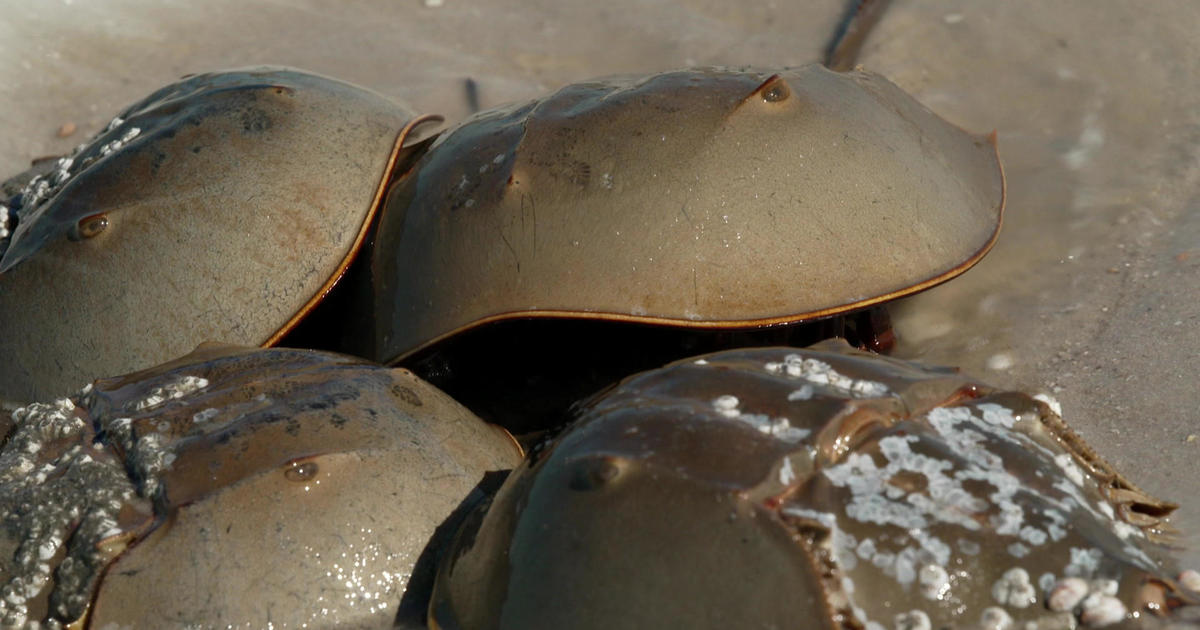
Watch CBS News
Be the first to know
Get browser notifications for breaking news, live events, and exclusive reporting.
Science & Environment
SpaceX to launch bitcoin entrepreneur and three crewmates on flight around Earth’s poles
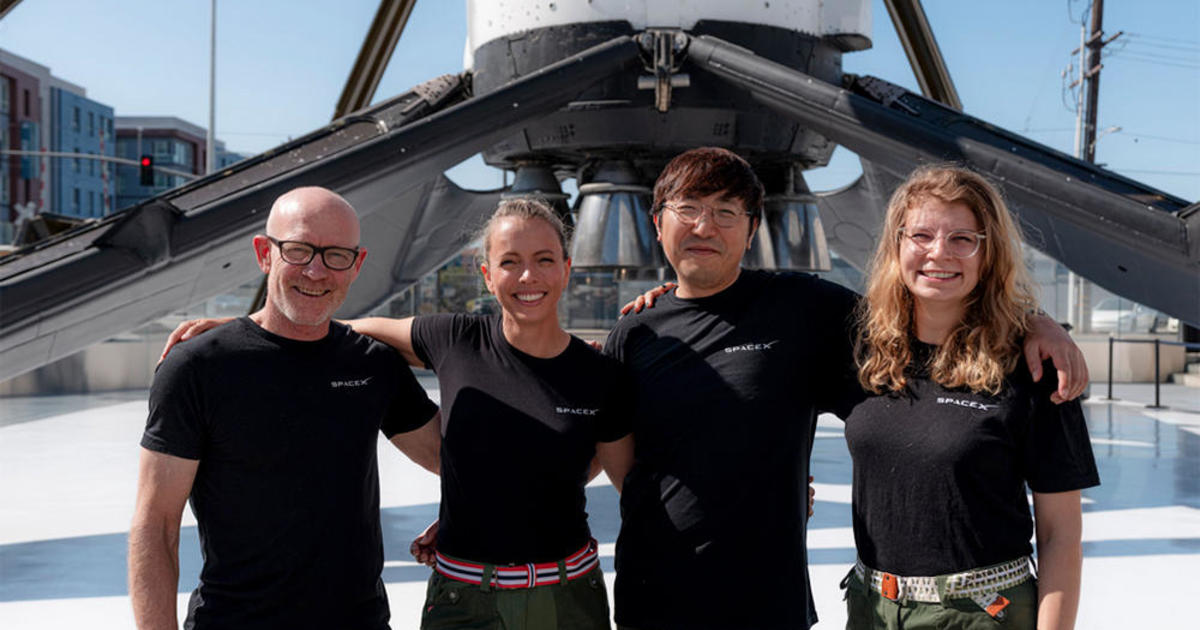
A blockchain entrepreneur, a cinematographer, a polar adventurer and a robotics researcher plan to fly around Earth’s poles aboard a SpaceX Crew Dragon capsule by the end of the year, becoming the first humans to observe the ice caps and extreme polar environments from orbit, SpaceX announced Monday.
The historic flight, launched from the Kennedy Space Center in Florida, will be commanded by Chun Wang, a wealthy bitcoin pioneer who founded f2pool and stakefish, “which are among the largest Bitcoin mining pools and Ethereum staking providers,” the crew’s website says.
“Wang aims to use the mission to highlight the crew’s explorational spirit, bring a sense of wonder and curiosity to the larger public and highlight how technology can help push the boundaries of exploration of Earth and through the mission’s research,” SpaceX said on its website.
Wang’s crewmates are Norwegian cinematographer Jannicke Mikkelsen, Australian adventurer Eric Philips and Rabea Rogge, a German robotics researcher. All four have an interest in extreme polar environments and plan to carry out related research and photography from orbit.
The mission, known as “Fram2” in honor of a Norwegian ship used to explore both the Arctic and Antarctic regions, will last three to five days and fly at altitudes between about 265 and 280 miles.
“This looks like a cool & well thought out mission. I wish the @framonauts the best on this epic exploration adventure!” tweeted Jared Isaacman, the billionaire philanthropist who charted the first private SpaceX mission — Inspiration4 — and who plans to blast off on a second flight — Polaris Dawn — later this month.
The flights “showcase what commercial missions can achieve thanks to @SpaceX’s reusability and NASA’s vision with the commercial crew program,” Isaacman said. “All just small steps towards unlocking the last great frontier.”
Like the Inspiration4 mission before them, Wang and his crewmates will fly in a Crew Dragon equipped with a transparent cupola giving them a picture-window view of Earth below and deep space beyond.
No astronauts or cosmonauts have ever viewed Earth from the vantage point of a polar orbit, one tilted, or inclined, 90 degrees to the equator. Such orbits are favored by spy satellites, weather stations and commercial photo-reconnaissance satellites because they fly over the entire planet as it rotates beneath them.
The high-inclination record for piloted flight was set in the early 1960s by Soviet Vostok spacecraft launched into orbits inclined 65 degrees. The U.S. record was set by a space shuttle mission launched in 1990 that carried out a classified military mission in an orbit tilted 62 degrees with respect to the equator.
The International Space Station never flies beyond 51.6 degrees north and south latitude. NASA planned to launch a space shuttle on a classified military mission around the poles in 1986, but the flight was canceled in the wake of the Challenger disaster.
“The North and South Poles are invisible to astronauts on the International Space Station, as well as to all previous human spaceflight missions except for the Apollo lunar missions but only from far away,” the Fram2 website says. “This new flight trajectory will unlock new possibilities for human spaceflight.”
SpaceX has launched 13 piloted missions carrying 50 astronauts, cosmonauts and private citizens to orbit in nine NASA flights to the space station, three commercial visits to the lab and the Inspiration4 mission chartered by Isaacman.
Isaacman and three crewmates plan to blast off Aug. 26 on another fully commercial flight, this one featuring the first civilian spacewalks. NASA plans to launch its next Crew Dragon flight to the space station around Sept. 24.
Science & Environment
Giant “flying” Joro spiders love big cities. A new study found their ability to chill out in stressful situations may be why
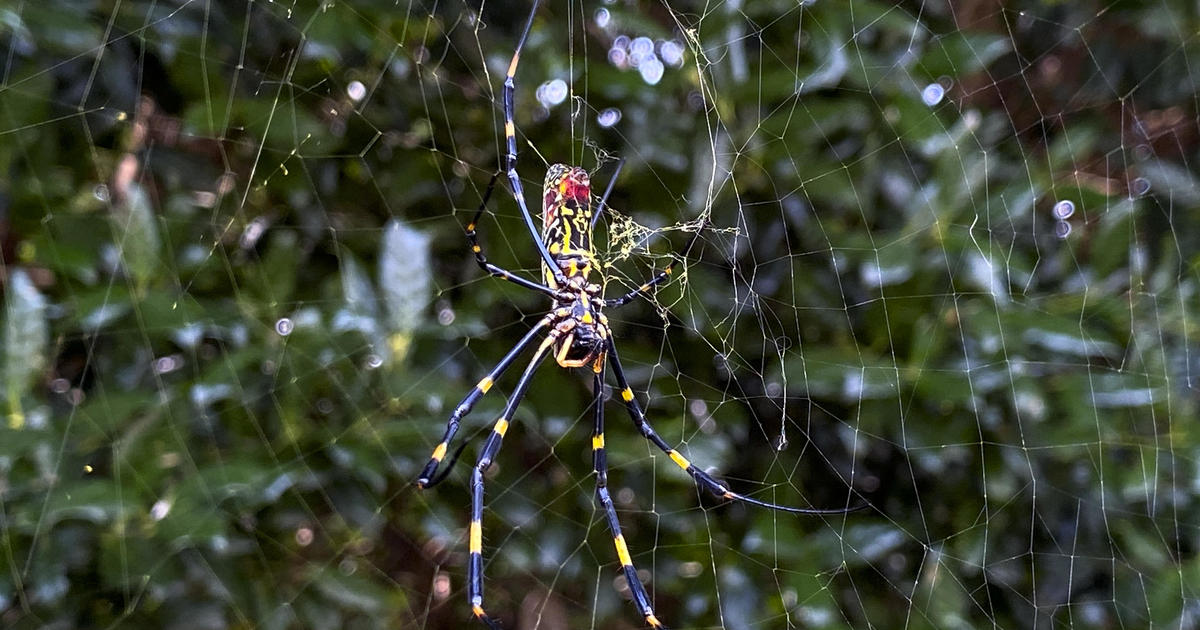
The saga of the large invasive Joro spiders that parachute through the air isn’t over. A new study found that the critters with 4-inch-long legs are truly built differently, with hearts that are able to withstand the loud and bustling noises of big cities.
University of Georgia researcher Andy Davis made the discovery while conducting cardiac stress tests on Joro spiders and their cousin, the golden silk spider. The research, published in Physiological Entomology on Monday, found that the species know how to chill out and stay calm when put in heart rate-raising situations.
The Joro spider, also known as Trichonephila clavata, “is known for making webs not only in natural green spaces but also in cities and towns, often on buildings and human dwellings,” the study says. “The stress reactions of Trichonephila spiders could be characterized as ‘even-tempered,’ which may factor into their ability to live in habitats with frequent disturbances.”
Davis and his team evaluated the physiological reactions of Joro spiders and golden silk spiders and compared them to those of another pair of similarly-sized species that are related to each other, garden spiders and banded garden spiders.
Researchers recorded baseline heart rates of the arachnids while they were resting and inactive, and then recorded their heart rates after restraining them under electronic sensors for 10 minutes.
“When subjected to the novel restraint stress, heart rates of all spider species became elevated, which is an expected reaction that other spider researchers have noted,” the study says. “However, there were differences among species in the magnitude of this elevation, and of how the responses progressed during the 10 min period.”
The garden spiders, both of which belong to the Argiope genus, showed “distinct periods of fluctuations during the restraint” and were even found to struggle against the restraints, researchers said. Joro spiders and their golden silk cousins, on the other hand, were “less variable and more even.” They were also observed entering a state of thanatosis for more than an hour after stressors, meaning they essentially froze up during that time.
The tests “are beginning to paint a picture of how the invasive Joro spider and its cousin, the golden silk spider, have a unique way of tolerating novel stressors, which may be the reason for their ability to occupy anthropogenic landscapes,” researchers said, noting that other spider species in their family line could share this trait, although that would need further investigation.
Joro spiders have been making headlines for years as they continue to spread up the East Coast. Originally from Asia, the spiders are believed to have been first introduced to north Georgia around 2010. They have since been found across nearly a dozen other states. In December, Davis told The New York Times that New York is “right in the middle of where they like to be.” It’s been predicted that they could pop up in the New York tri-state area this summer, although no reports of such have been made.
“They seem to be OK with living in a city,” he told the paper, adding that they’ve been seen hanging out on street lamps and telephone poles, where “regular spiders wouldn’t be caught dead in.”
The latest findings may not definitively prove that the spiders’ relaxed demeanor is the reason for “their affinity for urban settings,” the study says, adding that more research is needed. It does, however, bolster Davis’ research from February, which also found that Joro spiders don’t necessarily mind the increased noise and vibrations that come with city living.
“These Joro webs are everywhere in the fall, including right next to busy roads, and the spiders seem to be able to make a living there. For some reason, these spiders seem urban tolerant,” Davis said of his earlier research.
UGA student and co-author of that study, Alexa Schultz, agreed, saying, “It looks like Joro spiders are not going to shy away from building a web under a stoplight or an area where you wouldn’t imagine a spider to be.”
But don’t worry — while the spiders are venomous, they don’t pose a danger to humans, although they may elevate your heart rate more than you elevate theirs.
Science & Environment
New volcanic eruption in Iceland brings video of lava spewing from miles-long fissure on Reykjanes peninsula
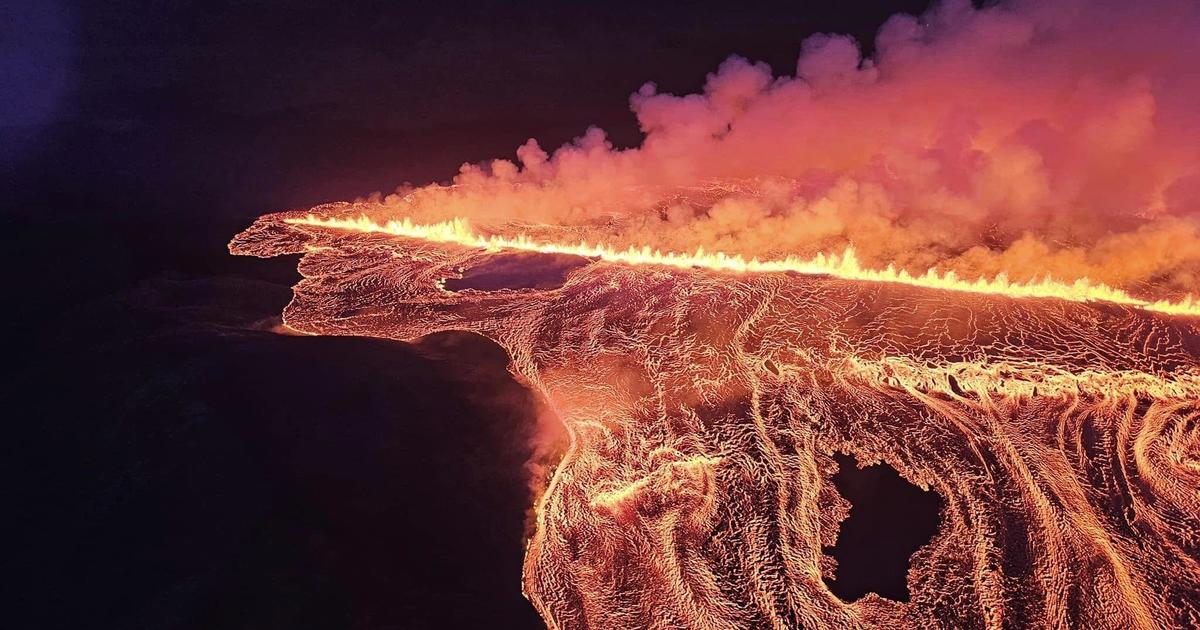
Reykjavik — Icelandic authorities said Friday that a second fissure had formed on the southwestern Reykjanes peninsula after lava started spewing forth for the sixth time in the region since December. After weeks of warnings, the Icelandic Meteorological Office (IMO) said Thursday that a new eruption had started at 9:26 p.m. (5:26 p.m. Eastern) that evening, following a series of earthquakes.
Video showed orange lava bursting out of a long fissure, which the IMO estimated to be 2.4 miles.
Early Friday, the IMO announced on social media that a second fissure had opened up to the north of the original one, but it said the volcanic activity mostly remained on the first crack.
The weather agency, which also monitors geological events, had previously reported that there was “considerable seismic activity” at the northern end of the fissure.
About an hour after the eruption started an earthquake with a magnitude of 4.1 was recorded in the area.
This is the sixth eruption to hit the area since December, coming just two months after the end of a previous eruption that lasted more than three weeks.
The chief of police of the Sudurnes region, Ulfar Ludviksson, told Icelandic media that the evacuation of the nearby fishing village of Grindavik had gone well.
He added that 22 or 23 houses in the village were currently occupied. Most of Grindavik’s 4,000 residents had evacuated in November, prior to a December eruption, and while residents have since been allowed to return in between eruptions, only a few have opted to stay overnight.
According to the IMO, there was no lava flowing towards Grindavik in the latest eruption.
Iceland’s famed Blue Lagoon thermal spa tourist attraction said late Thursday that it had taken “the precautionary measure of evacuating and temporarily closing all our operational units.”
The Reykjanes peninsula had not experienced an eruption for eight centuries until March 2021. Further eruptions occurred in August 2022 and in July and December 2023, leading volcanologists to warn that a new era of seismic activity had begun in the region.
Iceland is home to 33 active volcano systems, the highest number in Europe. It straddles the Mid-Atlantic Ridge, a crack in the ocean floor separating the Eurasian and North American tectonic plates.
Science & Environment
Matching dinosaur footprints found more than 3,700 miles apart, on different continents
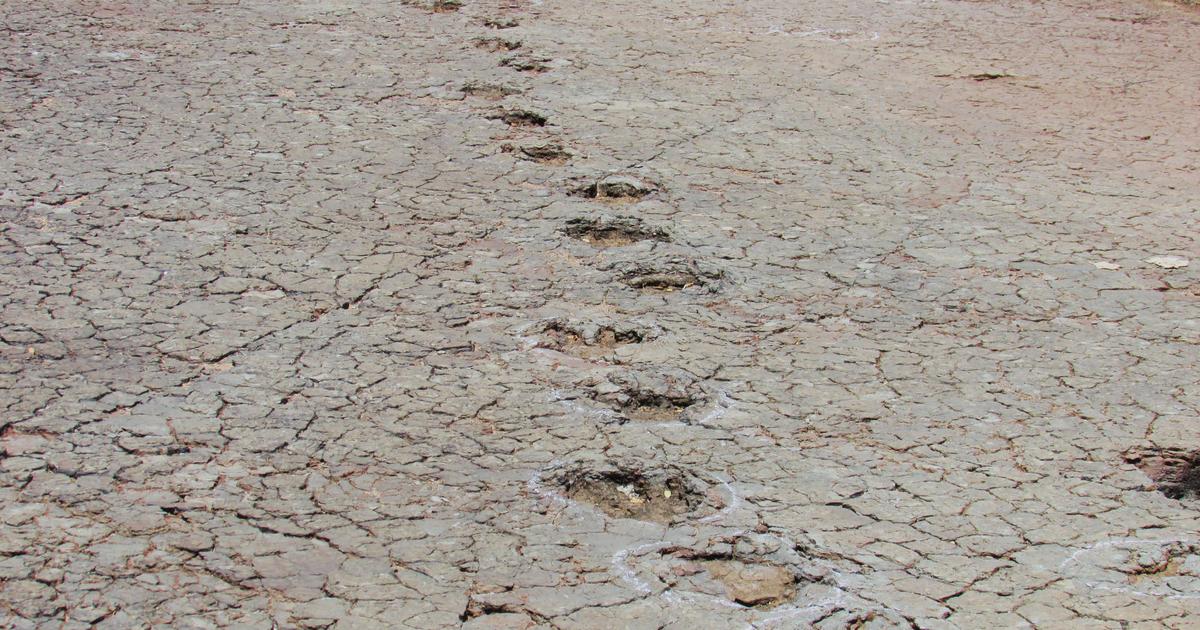
A team of paleontologists found matching dinosaur footprints on what are now two different continents, separated by thousands of miles of ocean.
The footprints, dating back to the Early Cretaceous period, were found in Brazil and in Cameroon, researchers wrote in a study published Monday by the New Mexico Museum of Natural History & Science. The discovery shows where land-dwelling dinosaurs were able to cross freely between South America and Africa before the two continents split apart millions of years ago.
Land shifts
The more than 260 footprints researchers studied were found impressed into mud and silt along ancient rivers and lakes, with more than 3,700 miles separating the ones in South America and Africa, according to the study. Paleontologists determined they were similar in age, shape and in geological and plate tectonic contexts.
Dinosaurs made the tracks 120 million years ago on a single supercontinent known as Gondwana, which had broken off from the larger landmass of Pangea — once the world’s only continent, Southern Methodist University paleontologist Louis Jacobs said.
“One of the youngest and narrowest geological connections between Africa and South America was the elbow of northeastern Brazil nestled against what is now the coast of Cameroon along the Gulf of Guinea,” Jacobs, the lead study author, said. “The two continents were continuous along that narrow stretch, so that animals on either side of that connection could potentially move across it.”
The continents now known as Africa and South America started to split around 140 million years ago, researchers said. The south Atlantic Ocean eventually filled the void.
Basins formed as the continents pulled apart; rivers flowed and lakes formed in those basins, Jacobs said. The basins where the footprints were discovered can be found on both sides of the split.
What we know about the dinosaurs
Most of the footprints were made by three-toed theropods, a group of carnivorous dinosaurs, researchers said. There were also prints left behind by sauropods or ornithischians.
“Plants fed the herbivores and supported a food chain,” Jacobs said. “Muddy sediments left by the rivers and lakes contain dinosaur footprints, including those of meat-eaters, documenting that these river valleys could provide specific avenues for life to travel across the continents 120 million years ago.”
-

 Sport7 hours ago
Sport7 hours agoJoshua vs Dubois: Chris Eubank Jr says ‘AJ’ could beat Tyson Fury and any other heavyweight in the world
-

 News1 day ago
News1 day agoYou’re a Hypocrite, And So Am I
-

 News8 hours ago
News8 hours agoIsrael strikes Lebanese targets as Hizbollah chief warns of ‘red lines’ crossed
-

 CryptoCurrency6 hours ago
CryptoCurrency6 hours agoEthereum is a 'contrarian bet' into 2025, says Bitwise exec
-

 Technology6 hours ago
Technology6 hours agoiPhone 15 Pro Max Camera Review: Depth and Reach
-

 CryptoCurrency7 hours ago
CryptoCurrency7 hours agoJourneys: Robby Yung on Animoca’s Web3 investments, TON and the Mocaverse
-

 CryptoCurrency7 hours ago
CryptoCurrency7 hours agoAre there ‘too many’ blockchains for gaming? Sui’s randomness feature: Web3 Gamer
-

 CryptoCurrency7 hours ago
CryptoCurrency7 hours agoHelp! My parents are addicted to Pi Network crypto tapper
-

 CryptoCurrency7 hours ago
CryptoCurrency7 hours agoSEC sues ‘fake’ crypto exchanges in first action on pig butchering scams
-

 CryptoCurrency7 hours ago
CryptoCurrency7 hours agoDecentraland X account hacked, phishing scam targets MANA airdrop
-

 CryptoCurrency7 hours ago
CryptoCurrency7 hours agoBitcoin miners steamrolled after electricity thefts, exchange ‘closure’ scam: Asia Express
-

 CryptoCurrency7 hours ago
CryptoCurrency7 hours agoCertiK Ventures discloses $45M investment plan to boost Web3
-

 CryptoCurrency7 hours ago
CryptoCurrency7 hours agoDorsey’s ‘marketplace of algorithms’ could fix social media… so why hasn’t it?
-

 CryptoCurrency7 hours ago
CryptoCurrency7 hours agoSEC asks court for four months to produce documents for Coinbase
-

 Sport7 hours ago
Sport7 hours agoUFC Edmonton fight card revealed, including Brandon Moreno vs. Amir Albazi headliner
-

 Football7 hours ago
Football7 hours agoNiamh Charles: Chelsea defender has successful shoulder surgery
-

 Science & Environment10 hours ago
Science & Environment10 hours agoHow one theory ties together everything we know about the universe
-

 CryptoCurrency7 hours ago
CryptoCurrency7 hours agoSEC settles with Rari Capital over DeFi pools, unregistered broker activity
-

 News5 hours ago
News5 hours agoBrian Tyree Henry on voicing young Megatron, his love for villain roles
-

 Science & Environment21 hours ago
Science & Environment21 hours agoQuantum time travel: The experiment to ‘send a particle into the past’
-

 Science & Environment7 hours ago
Science & Environment7 hours agoWe may have spotted a parallel universe going backwards in time
-

 CryptoCurrency7 hours ago
CryptoCurrency7 hours ago2 auditors miss $27M Penpie flaw, Pythia’s ‘claim rewards’ bug: Crypto-Sec
-

 CryptoCurrency7 hours ago
CryptoCurrency7 hours agoArthur Hayes’ ‘sub $50K’ Bitcoin call, Mt. Gox CEO’s new exchange, and more: Hodler’s Digest, Sept. 1 – 7
-

 CryptoCurrency7 hours ago
CryptoCurrency7 hours agoTreason in Taiwan paid in Tether, East’s crypto exchange resurgence: Asia Express
-

 CryptoCurrency7 hours ago
CryptoCurrency7 hours agoLeaked Chainalysis video suggests Monero transactions may be traceable
-

 CryptoCurrency7 hours ago
CryptoCurrency7 hours agoLouisiana takes first crypto payment over Bitcoin Lightning
-

 CryptoCurrency7 hours ago
CryptoCurrency7 hours agoCrypto whales like Humpy are gaming DAO votes — but there are solutions
-

 CryptoCurrency7 hours ago
CryptoCurrency7 hours agoFive crypto market predictions that haven’t come true — yet
-

 CryptoCurrency7 hours ago
CryptoCurrency7 hours ago$12.1M fraud suspect with ‘new face’ arrested, crypto scam boiler rooms busted: Asia Express
-

 CryptoCurrency7 hours ago
CryptoCurrency7 hours ago‘Everything feels like it’s going to shit’: Peter McCormack reveals new podcast
-

 CryptoCurrency7 hours ago
CryptoCurrency7 hours agoReal-world asset tokenization is the crypto killer app — Polygon exec
-

 Science & Environment10 hours ago
Science & Environment10 hours agoFuture of fusion: How the UK’s JET reactor paved the way for ITER
-

 CryptoCurrency7 hours ago
CryptoCurrency7 hours agoFed rate cut may be politically motivated, will increase inflation: Arthur Hayes
-

 CryptoCurrency7 hours ago
CryptoCurrency7 hours agoBinance CEO says task force is working ‘across the clock’ to free exec in Nigeria
-

 CryptoCurrency7 hours ago
CryptoCurrency7 hours agoElon Musk is worth 100K followers: Yat Siu, X Hall of Flame
-

 CryptoCurrency7 hours ago
CryptoCurrency7 hours agoBitcoin price hits $62.6K as Fed 'crisis' move sparks US stocks warning
-

 CryptoCurrency7 hours ago
CryptoCurrency7 hours agoCZ and Binance face new lawsuit, RFK Jr suspends campaign, and more: Hodler’s Digest Aug. 18 – 24
-

 CryptoCurrency7 hours ago
CryptoCurrency7 hours agoCardano founder to meet Argentina president Javier Milei
-

 CryptoCurrency7 hours ago
CryptoCurrency7 hours agoMemecoins not the ‘right move’ for celebs, but DApps might be — Skale Labs CMO
-

 CryptoCurrency7 hours ago
CryptoCurrency7 hours agoBitcoin bull rally far from over, MetaMask partners with Mastercard, and more: Hodler’s Digest Aug 11 – 17
-

 CryptoCurrency7 hours ago
CryptoCurrency7 hours agoTelegram bot Banana Gun’s users drained of over $1.9M
-

 CryptoCurrency7 hours ago
CryptoCurrency7 hours agoLow users, sex predators kill Korean metaverses, 3AC sues Terra: Asia Express
-

 CryptoCurrency7 hours ago
CryptoCurrency7 hours agoEthereum falls to new 42-month low vs. Bitcoin — Bottom or more pain ahead?
-

 CryptoCurrency7 hours ago
CryptoCurrency7 hours agoBlockdaemon mulls 2026 IPO: Report
-
Business6 hours ago
How Labour donor’s largesse tarnished government’s squeaky clean image
-
Business6 hours ago
UK hospitals with potentially dangerous concrete to be redeveloped
-

 News5 hours ago
News5 hours ago“Beast Games” contestants sue MrBeast’s production company over “chronic mistreatment”
-

 News5 hours ago
News5 hours agoSean “Diddy” Combs denied bail again in federal sex trafficking case in New York
-

 News5 hours ago
News5 hours agoBrian Tyree Henry on his love for playing villains ahead of “Transformers One” release
-

 Technology3 days ago
Technology3 days agoYouTube restricts teenager access to fitness videos
-

 News9 hours ago
News9 hours agoChurch same-sex split affecting bishop appointments
-

 Politics2 days ago
Politics2 days agoTrump says he will meet with Indian Prime Minister Narendra Modi next week
-

 Science & Environment11 hours ago
Science & Environment11 hours agoPhysicists have worked out how to melt any material
-

 Science & Environment10 hours ago
Science & Environment10 hours ago‘Running of the bulls’ festival crowds move like charged particles
-

 Politics21 hours ago
Politics21 hours agoWhat is the House of Lords, how does it work and how is it changing?
-

 MMA7 hours ago
MMA7 hours agoUFC’s Cory Sandhagen says Deiveson Figueiredo turned down fight offer
-

 MMA7 hours ago
MMA7 hours agoDiego Lopes declines Movsar Evloev’s request to step in at UFC 307
-

 Football7 hours ago
Football7 hours agoSlot's midfield tweak key to Liverpool victory in Milan
-

 Science & Environment10 hours ago
Science & Environment10 hours agoHow to wrap your head around the most mind-bending theories of reality
-

 Fashion Models6 hours ago
Fashion Models6 hours agoMiranda Kerr nude
-

 Politics6 hours ago
Politics6 hours agoLabour MP urges UK government to nationalise Grangemouth refinery
-

 Science & Environment14 hours ago
Science & Environment14 hours agoHow Peter Higgs revealed the forces that hold the universe together
-

 News4 days ago
News4 days agoIndia Now Moves from Deliberations to Deliverables on Crimes Against Women
-

 Science & Environment16 hours ago
Science & Environment16 hours agoQuantum forces used to automatically assemble tiny device
-

 Science & Environment10 hours ago
Science & Environment10 hours agoRethinking space and time could let us do away with dark matter
-

 Entertainment5 hours ago
Entertainment5 hours ago“Jimmy Carter 100” concert celebrates former president’s 100th birthday
-

 Science & Environment18 hours ago
Science & Environment18 hours agoSunlight-trapping device can generate temperatures over 1000°C
-

 News5 hours ago
News5 hours agoJoe Posnanski revisits iconic football moments in new book, “Why We Love Football”
-

 Health & fitness2 days ago
Health & fitness2 days agoHow to adopt mindful drinking in 2022
-

 Health & fitness2 days ago
Health & fitness2 days agoWhat 10 days of a clean eating plan actually does to your body and why to adopt this diet in 2022
-

 Health & fitness2 days ago
Health & fitness2 days agoWhen Britons need GoFundMe to pay for surgery, it’s clear the NHS backlog is a political time bomb
-

 Science & Environment20 hours ago
Science & Environment20 hours agoQuantum to cosmos: Why scale is vital to our understanding of reality
-

 Technology3 days ago
Technology3 days agoTrump says Musk could head ‘government efficiency’ force
-

 Science & Environment20 hours ago
Science & Environment20 hours agoX-ray laser fires most powerful pulse ever recorded
-

 Science & Environment19 hours ago
Science & Environment19 hours agoHow indefinite causality could lead us to a theory of quantum gravity
-

 Science & Environment18 hours ago
Science & Environment18 hours agoDoughnut-shaped swirls of laser light can be used to transmit images
-
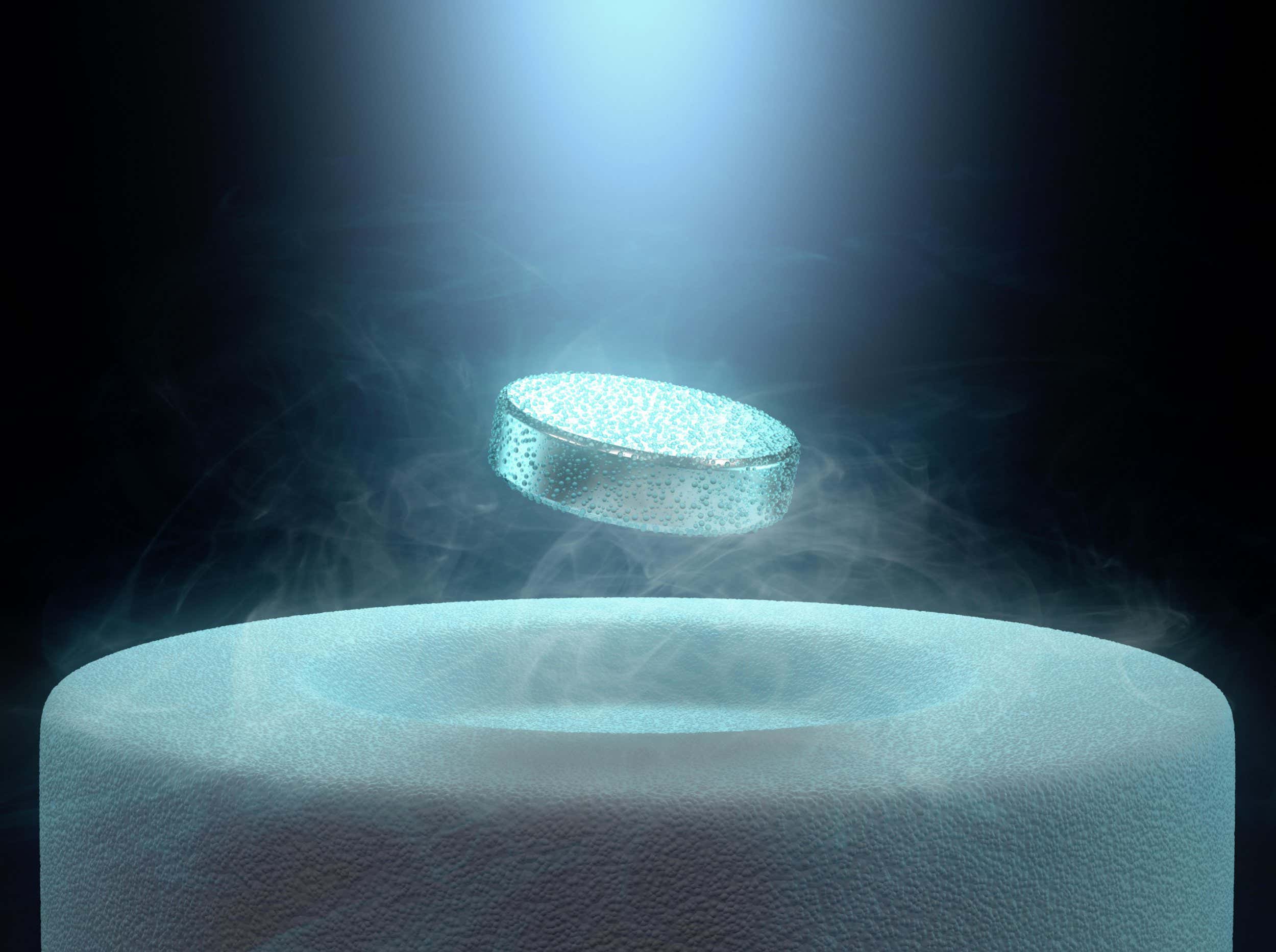
 Science & Environment17 hours ago
Science & Environment17 hours agoWhy we are finally within reach of a room-temperature superconductor
-
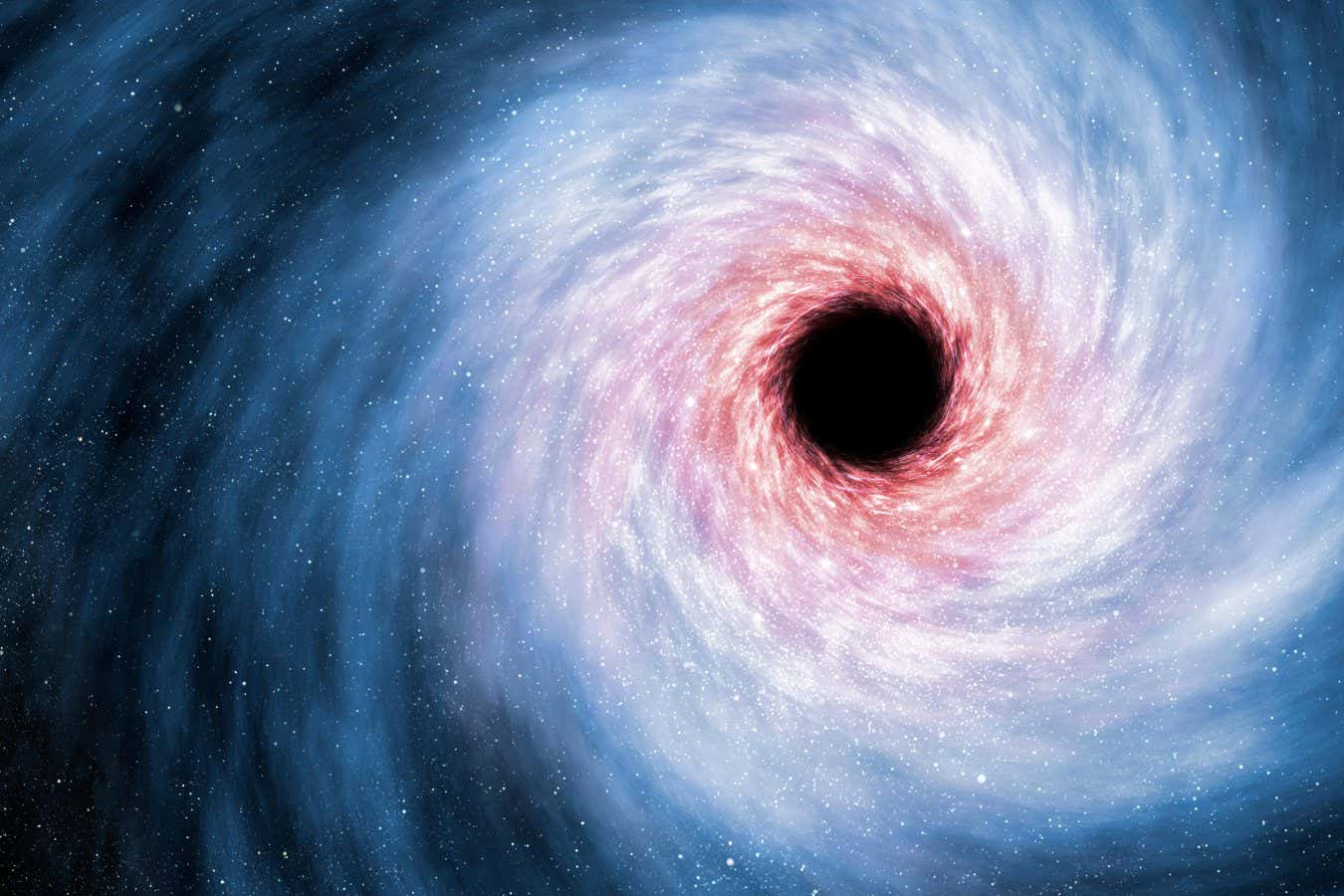
 Science & Environment16 hours ago
Science & Environment16 hours agoBlack holes scramble information – but may not be the best at it
-

 Science & Environment16 hours ago
Science & Environment16 hours agoThe galactic anomalies hinting dark matter is weirder than we thought
-

 CryptoCurrency7 hours ago
CryptoCurrency7 hours agoTelegram CEO cannot leave France, OpenSea receives Wells notice, and more: Hodler’s Digest, Aug. 25 – 31
-

 CryptoCurrency7 hours ago
CryptoCurrency7 hours agoSolana unveils new Seeker device, says it’s not just a ‘memecoin phone’
-

 CryptoCurrency7 hours ago
CryptoCurrency7 hours agoCrypto scammers orchestrate massive hack on X but barely made $8K
-

 CryptoCurrency7 hours ago
CryptoCurrency7 hours agoBitcoiners are ‘all in’ on Trump since Bitcoin ’24, but it’s getting risky
-

 Science & Environment10 hours ago
Science & Environment10 hours ago‘Sound laser’ is the most powerful ever made
-

 Science & Environment10 hours ago
Science & Environment10 hours agoJupiter’s stormy surface replicated in lab
-
Politics10 hours ago
Owen Paterson loses ECHR appeal against report that preceded downfall | Owen Paterson
-

 CryptoCurrency7 hours ago
CryptoCurrency7 hours agoDuckDuckGo ranks Etherscan phishing websites in top results
-

 CryptoCurrency7 hours ago
CryptoCurrency7 hours agoVonMises bought 60 CryptoPunks in a month before the price spiked: NFT Collector
-

 CryptoCurrency7 hours ago
CryptoCurrency7 hours agoVitalik tells Ethereum L2s ‘Stage 1 or GTFO’ — Who makes the cut?
-

 CryptoCurrency7 hours ago
CryptoCurrency7 hours agoETH falls 6% amid Trump assassination attempt, looming rate cuts, ‘FUD’ wave
-
Business7 hours ago
Thames Water seeks extension on debt terms to avoid renationalisation
-
Business5 hours ago
Axel Springer top team close to making eight times their money in KKR deal
-

 News5 hours ago
News5 hours agoEddie Vedder on the origin of Pearl Jam: “It was heaven”
-

 News5 hours ago
News5 hours agoSean “Diddy” Combs denied bail again in federal sex trafficking case
-

 News5 hours ago
News5 hours agoBrian Tyree Henry on voicing young Megatron, his love for villain roles
-
Business5 hours ago
John Paulson brushes aside Wall Street worries about Donald Trump’s tariff plan
-
Politics5 hours ago
Why is Sue Gray at the centre of a new political storm? | Sue Gray
-

 News4 hours ago
News4 hours agoWoman sues Florida sheriff after mistaken arrest lands her in jail on Christmas
-

 News4 hours ago
News4 hours agoGlobal Tensions and Press Freedom
-

 News9 hours ago
News9 hours agoPolice chief says Daniel Greenwood 'used rank to pursue junior officer'







You must be logged in to post a comment Login